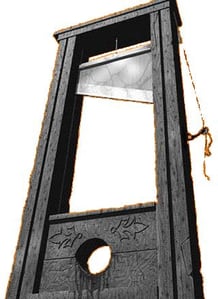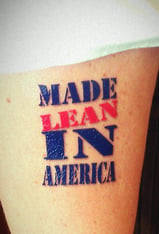 One of the more dubious outcomes of the French Revolution was the standardization of guillotining as the sole (and oft-employed) manner of capital punishment. Prior to the revolution, only nobility was entitled to such a humane demise. Commoners received their due by more excruciating means such as drawing and quartering. Today, it seems that American businesses suffer both fates.
One of the more dubious outcomes of the French Revolution was the standardization of guillotining as the sole (and oft-employed) manner of capital punishment. Prior to the revolution, only nobility was entitled to such a humane demise. Commoners received their due by more excruciating means such as drawing and quartering. Today, it seems that American businesses suffer both fates.
For the last four decades in the name of efficiency, business entities have been ripped into pieces for consolidation with like entities from other regions. These attempts to ‘economize’ draw and quarter the cultures that have made the individual businesses creative and competitive. Employees, the most valuable resource, are driven to other occupations, their process knowledge lost forever. Only the ‘big brains’ are offered a chance to relocate. Machines are moved too, but the people who do the work are displaced. A manager responsible for these kind of consolidations confided to me about a recent plant closing and consolidation, “Strategically we lost far more in the good ideas, creativity and improvement thinking from company A, than we gained through economies of scale from its closing. But I couldn’t quantify the improvement part, so I had no choice.”
The sales proposition for consolidation is simple: 1 + 1 >> 2. In the short term, this appears to be true. As redundant jobs are eliminated (heads chopped) the bottom-line improves. A similar effect occurred at General Motors in the 1990’s: each time heads were chopped, the stock price increased – as did executive bonuses. To be sure, there are times when consolidation of resources can provide a unique synergy by gathering the best process knowledge together. But more often, only short-term gains are realized. In the longer term 1 + 1 << 1.
Around 1990, another mode of corporate execution became the strategy of choice: outsourcing. This began in high tech but has since spread to virtually every industry, public and private. I belonged to a regional Vice President of Operations Group in the ‘90’s where 75% of the members managed virtual organizations. They had a small administrative staff working for them but everything else was outsourced. I was Alice in Wonderland, still struggling to make products in the U.S. while most of the rest of the group preferred to discuss their stock options. Here was the rationale:
“Manufacturing is not a core competency. Our strength is innovation."
"We live in a new age of commoditization,” they said, “outsourcing is the wave of the future.”
More like a tsunami. Guillotine! Separate the body from the head, leave the head here in the U.S. and ship the rest to the lowest wage locale available. Let the philosopher kings in the U.S. create, innovate and incubate. Ship the “low level” work somewhere else.
Once again, on paper the concept looked ingenious: 1 - .90 >> 1. Short-term earnings soared. But in actuality, undervalued production technology and process improvement was lost, ceded to other regions, who today are the new proprietors. A manufacturer of leather handbags commented to me, “We initially shipped our ‘low cost’ products” to China, but now those products are of higher quality than the ones we make here!” A manufacturer of sporting goods noted, “There are portions of our product for which the technology has been completely lost. We couldn’t buy it in the U.S. if we wanted to.” The emerging producers from far off places are not headless bodies, but whole entities that have assumed leadership in markets ranging from consumer electronics to automotive to healthcare. They can still go to the Gemba to observe and improve, because they have one.
Some days the trend to export jobs rather than products seems inexorable. On the other hand, there are notable product and service providers in our region who have made a choice to build their futures in America by learning to compete in the global economy – and they are thriving! This is the theme of our October 5-6 Northeast Shingo Prize Conference: Made Lean In America. A distinguished group of lean leaders will be with us then, as will two dozen lean practitioners from lean organizations large and small, sharing ideas in our “lean lounge.” I hope you’ll plan to be there with us also.
In the meantime, let me hear your thoughts. Can your company make it in America?
O.L.D.

P.S. Request a few of our "Made Lean In America" temporary tattoos
by emailing your address to Lglikes@gbmp.org
(let us know how many you'd like; limit 25 per person).


